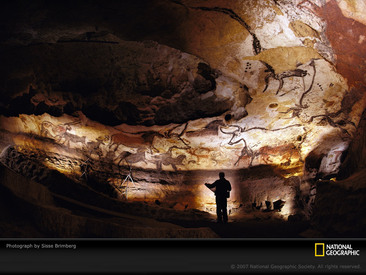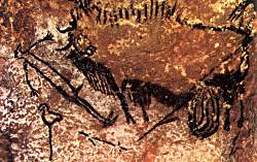Lascaux Cave

The walls of the Lascaux Cave in France's Dordogne River Valley.
Marcel Ravidat was walking his dog Robot in the woods, surrounding Montignac. The dog discovered a hole in the ground and crawled in, to search for its residents. The boy heard a whine and the dog was gone. When he crawled into the hole carefully, he discovered a drop. Obviously the dog had fallen down into a bigger cave. He alarmed three friends, Jacques Marsal, Georges Agnel, and Simon Coencas. Together, they climbed down the drop and rescued the dog. When Ravidat explored another drop at the end of the cave, which turned out to be a dead end, he turned around and saw an extraordinary picture on the wall. It was a sketch of a man who was probably killed during a hunt. The picture was extraordinary, so they told their teacher, Leon Laval, about their discovery. He was so impressed that he wrote to Abbe Henri Breuil, at that time the most famous French archaeologist. Breuil explored the cave for years and published his work internationally. Soon the cave became world renowned, was developed as a show cave, and in 1948 opened to the public (The Cave of Lascaux).
This is one of the many stories told of possibilities of how the cave was found. The cave of Lascaux was discovered on September 12, 1940 by four young boys. No one knows what truly happened and there are only stories like the one above (The Cave of Lascaux). The Lascaux cave is known as the best known cave. It is famous for its prehistoric paintings, such as the one shown on the top of the page. The Sixtine Chapel of Prehistory is what the Lascaux cave is often called. There are 1,500 engravings and 600 drawings documented. They are about 17,000 years old. The images range from animals, hunt, and war scenes (The Cave of Lascaux).
These artworks have been announced the oldest paintings of all time and the beginning of art. However, it is, in fact, not the oldest. Researchers believe that there was some kind of system that allowed some people to paint while others went to hunt. The hunts were drawn on the wall like a comic strip. The images are suggesting that they were used to tell stories. They were drawn from left to right until the prey was captured. There is a first chamber called the Chamber of Bulls. It is the most impressive chamber of the cave. It has numerous animal paintings on the walls. Most of the painted animals are bulls. The oldest paintings of the cave were drawn in either red or yellow and the people made sure to keep them uncovered by newer images (The Cave of Lascaux).
The Great Bull is the largest center painting. It measures at 5.50 meters long. Another animal shown is the unicorn. It has unusually large hindquarters, a pronounced abdomen, and two straight elongated horns. When the head is viewed from a specific angle, there is a resemblance of a human face. There is also a passage of red cows. The cow covered passage leads to a third chamber. At one point, it contained hundreds of paintings. Now, it is destroyed from the erosion and the walls above ground are ruined. The lower part of the wall hat was protected by the debris, is still preserved. The lower wall shows 122 horses, 25 wild oxen, 2 bison, 4 ibex and many other large abstract shapes (The Cave of Lascaux).
The paintings of the cave are not fragile. The years have caused the paintings to react from the cave’s natural climate. The color black is from charcoal and the brown and red colors are from clay. They used ochre, charcoal, and iron oxides. The humidity and low temperature of the cave has kept the paintings preserved. Authorities closed the cave in 1963 to protect the paintings from green sickness, white sickness, and bleaching from the sun (The Cave of Lascaux).
This is one of the many stories told of possibilities of how the cave was found. The cave of Lascaux was discovered on September 12, 1940 by four young boys. No one knows what truly happened and there are only stories like the one above (The Cave of Lascaux). The Lascaux cave is known as the best known cave. It is famous for its prehistoric paintings, such as the one shown on the top of the page. The Sixtine Chapel of Prehistory is what the Lascaux cave is often called. There are 1,500 engravings and 600 drawings documented. They are about 17,000 years old. The images range from animals, hunt, and war scenes (The Cave of Lascaux).
These artworks have been announced the oldest paintings of all time and the beginning of art. However, it is, in fact, not the oldest. Researchers believe that there was some kind of system that allowed some people to paint while others went to hunt. The hunts were drawn on the wall like a comic strip. The images are suggesting that they were used to tell stories. They were drawn from left to right until the prey was captured. There is a first chamber called the Chamber of Bulls. It is the most impressive chamber of the cave. It has numerous animal paintings on the walls. Most of the painted animals are bulls. The oldest paintings of the cave were drawn in either red or yellow and the people made sure to keep them uncovered by newer images (The Cave of Lascaux).
The Great Bull is the largest center painting. It measures at 5.50 meters long. Another animal shown is the unicorn. It has unusually large hindquarters, a pronounced abdomen, and two straight elongated horns. When the head is viewed from a specific angle, there is a resemblance of a human face. There is also a passage of red cows. The cow covered passage leads to a third chamber. At one point, it contained hundreds of paintings. Now, it is destroyed from the erosion and the walls above ground are ruined. The lower part of the wall hat was protected by the debris, is still preserved. The lower wall shows 122 horses, 25 wild oxen, 2 bison, 4 ibex and many other large abstract shapes (The Cave of Lascaux).
The paintings of the cave are not fragile. The years have caused the paintings to react from the cave’s natural climate. The color black is from charcoal and the brown and red colors are from clay. They used ochre, charcoal, and iron oxides. The humidity and low temperature of the cave has kept the paintings preserved. Authorities closed the cave in 1963 to protect the paintings from green sickness, white sickness, and bleaching from the sun (The Cave of Lascaux).
Definitions
Bleaching
Chamber
Erosion
Hindquarters
Humidity
Chamber
Erosion
Hindquarters
Humidity
-To remove the color from by means of chemical agents or sunlight.
-National or artificial enclosed space or cavity.
-A type of weathering in which surface soil and rock are worn away through the action of glaciers, water, and wind.
-The posterior portion of a side of beef, lamb, veal, or mutton, inluding a hind leg and one or two ribs.
-The ratio of the amount of water vapor in the air at a specific temperature to the maximum amount that the air could hold at that temperature.
-National or artificial enclosed space or cavity.
-A type of weathering in which surface soil and rock are worn away through the action of glaciers, water, and wind.
-The posterior portion of a side of beef, lamb, veal, or mutton, inluding a hind leg and one or two ribs.
-The ratio of the amount of water vapor in the air at a specific temperature to the maximum amount that the air could hold at that temperature.




